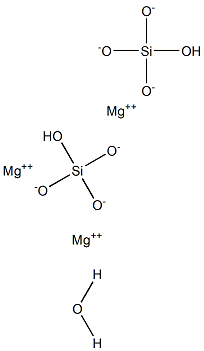Chrysotile (Mg3H2(SiO4)2.H2O)
- CAS No.
- 12001-29-5
- Chemical Name:
- Chrysotile (Mg3H2(SiO4)2.H2O)
- Synonyms
- Chrysotile.;CHRYSOTILEA;SHORTCHRYSOTILE;asbestos, white;ASBESTOS,CHRYSOTILE;Chrysotile (Mg3H2(SiO4)2.H2O);Asbestos fibers total (chrysotile);Asbestos (chrysotile) fibers/cc or ml
- CBNumber:
- CB71212605
- Molecular Formula:
- H4Mg3O9Si2
- Molecular Weight:
- 277.11236
- MDL Number:
- MOL File:
- 12001-29-5.mol
| Melting point | 800-850 °C |
|---|---|
| Density | 2.2-2.6 g/cm3 |
| color | Silky white to green to brownish fibers |
| Indirect Additives used in Food Contact Substances | CHRYSOTILE |
| FDA UNII | 8FDH1JN7VQ |
| IARC | 1 (Vol. 14, Sup 7, 100C) 2012 |
| EPA Substance Registry System | Chrysotile (12001-29-5) |
SAFETY
Risk and Safety Statements
| Symbol(GHS) |  GHS08 |
|---|---|
| Signal word | Danger |
| Hazard statements | H350-H372 |
| Precautionary statements | P260-P264-P270-P314-P501 |
| RIDADR | 2590 |
| HazardClass | 9 |
| PackingGroup | III |
| Toxicity | TCLo inhalation in human: 2.8fb/cc/5Y |
Chrysotile (Mg3H2(SiO4)2.H2O) Chemical Properties,Uses,Production
Chemical Properties
White or greenish (chrysotile), Blue (crocidolite), or gray-green (amosite) fibrous, odorless solids; freezing/ melting point5600 C (Decomposes). Hazard identification (based on NFPA-704 M Rating System): Health 2; flammability 0; reactivity 0. Insoluble in water. Asbestos is a generic term that applies to a number of naturally occurring, hydrated mineral silicates incombustible in air and separable into filaments. The most widely used in industry in the United States is chrysotile, a fibrous form of serpentine. Other types include amosite, crocidolite, tremolite, anthophyllite, and actinolite.
General Description
White asbestos is a slender, fine, flaxy fiber. Long term occupational exposure to the dust can result in lung cancer. Asbestos is resistant to fire and most solvents. The primary hazard is the threat to the environment. Immediate steps should be taken to limit its spread to the environment. Chrysotile (Mg3H2(SiO4)2.H2O) is used as a heat resistant material, in cement, furnace bricks, and brake linings.
Air & Water Reactions
Insoluble in water.
Reactivity Profile
These substances undergo chemical reactions only under relatively severe circumstances or in the presence of an effective catalyst that promotes reaction. They are resistant to ignition, although they may become flammable at very high temperatures. They will be resistant to oxidation/reduction, except in the most severe conditions.
Health Hazard
Inhalation of material may be harmful. Contact may cause burns to skin and eyes. Inhalation of Asbestos dust may have a damaging effect on the lungs. Fire may produce irritating, corrosive and/or toxic gases. Some liquids produce vapors that may cause dizziness or suffocation. Runoff from fire control may cause pollution.
Fire Hazard
Some may burn but none ignite readily. Containers may explode when heated. Some may be transported hot.
Safety Profile
Confirmed human carcinogen producing tumors of the lung. Human mutation data reported. Poison by intraperitoneal route. Human systemic effects by inhalation: lung fibrosis, dyspnea, and cough.
Potential Exposure
Most asbestos is used in the construction industry. Much of it is firmly bonded, i.e., the asbestos is “locked in” in such products as floor tiles, asbestos cements, and roofing felts, and shingles; while the remaining 8% is friable or in powder forms present in insulation materials, asbestos cement powders, and acoustical products. As expected, these latter materials generate more airborne fibers than the firmly bonded products. The asbestos used in nonconstruction industries is utilized in such products as textiles; friction material including brake linings and clutch facings; paper, paints, plastics, roof coatings; floor tiles, and miscellaneous other products. Significant quantities of asbestos fibers appear in rivers and streams draining from areas where asbestos-rock outcroppings are found. Some of these outcroppings are being mined. Asbestos fibers have been found in a number of drinking water supplies, but the health implications of ingesting asbestos are not fully documented. Emissions of asbestos fibers into water and air are known to result from mining and processing of some minerals. Exposure to asbestos fibers may occur throughout urban environments perhaps resulting from asbestos from brake linings and the flaking of sprayed asbestos insulation material. In recent years, much effort has been put into removal of asbestos insulation, particularly from schools and other public buildings where worn or exposed asbestos causes public exposure. Incompatibilities: None
Shipping
UN2212 Blue asbestos (Crocidolite) or Brown asbestos (amosite, mysorite), Hazard class: 9; Labels: 9-Miscellaneous hazardous material. UN2590 White asbestos (chrysotile, actinolite, anthophyllite, tremolite), Hazard class: 9; Labels: 9-Miscellaneous hazardous material.
Waste Disposal
Asbestos may be recovered from waste asbestos slurries as an alternative to disposal. Landfilling is an option for disposal if carefully controlled.
Chrysotile (Mg3H2(SiO4)2.H2O) Preparation Products And Raw materials
Raw materials
Preparation Products
| Supplier | Tel | Country | ProdList | Advantage | |
|---|---|---|---|---|---|
| Portail Substances Chimiques | -- | webmestre-substances@ineris.fr | France | 6027 | 58 |
| SKC Inc. | -- | skcorder@skcinc.com | United States | 1379 | 76 |
| Structure Probe, Inc. | -- | spi3spi@2spi.com | United States | 269 | 82 |
| Agfa Geveart BV | -- | jeff.lewis@agfa.com | Belgium | 107 | 86 |
| HONEST JOY HOLDINGS LIMITED | -- | sales@honestjoy.cn | United States | 6702 | 54 |
| Supplier | Advantage |
|---|---|
| Portail Substances Chimiques | 58 |
| SKC Inc. | 76 |
| Structure Probe, Inc. | 82 |
| Agfa Geveart BV | 86 |
| HONEST JOY HOLDINGS LIMITED | 54 |





